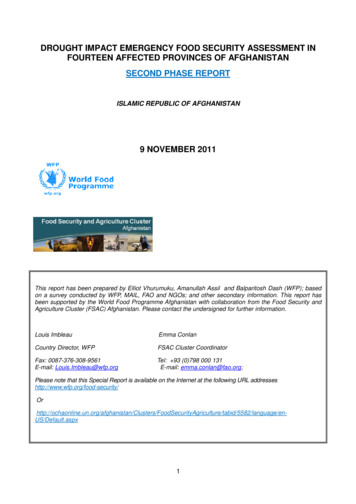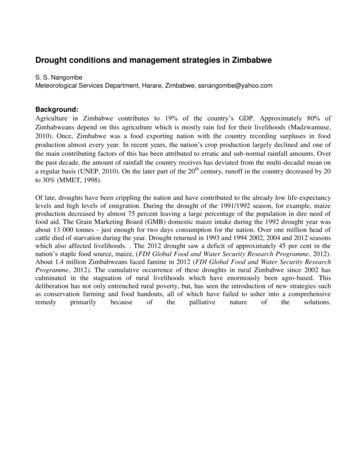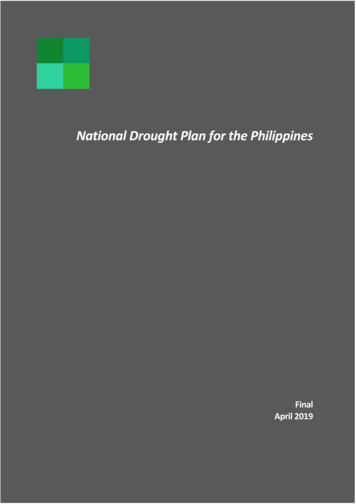
Transcription
DROUGHT IMPACT EMERGENCY FOOD SECURITY ASSESSMENT INFOURTEEN AFFECTED PROVINCES OF AFGHANISTANSECOND PHASE REPORTISLAMIC REPUBLIC OF AFGHANISTAN9 NOVEMBER 2011This report has been prepared by Elliot Vhurumuku, Amanullah Assil and Balparitosh Dash (WFP); basedon a survey conducted by WFP, MAIL, FAO and NGOs; and other secondary information. This report hasbeen supported by the World Food Programme Afghanistan with collaboration from the Food Security andAgriculture Cluster (FSAC) Afghanistan. Please contact the undersigned for further information.Louis ImbleauEmma ConlanCountry Director, WFPFSAC Cluster CoordinatorFax: 0087-376-308-9561E-mail: Louis.Imbleau@wfp.orgTel: 93 (0)798 000 131E-mail: emma.conlan@fao.org;Please note that this Special Report is available on the Internet at the following URL x1
Table of Contents1.KEY MESSAGE . 62. BACKGROUND . 72. OBJECTIVES . 73. ASSESSMENT METHODOLOGY . 83.1. APPLICATION OF WEIGHTS . 93.2. LIMITATIONS OF THE STUDY.105. DROUGHT IMPACT ON HUMAN AND SOCIAL CAPITAL .115.1. COMMUNITY AND HOUSEHOLD PERSPECTIVES ON DROUGHT .115.1.1. Drought Analogue Years .115.1.2. Impression of Impact of drought on Livelihoods .125.1.3. Impact of drought on crop growing stages .135.2. DEMOGRAPHY AND POPULATION DISPLACEMENT .155.2.1 Marital Status and Education level of Head of household .155.2.2. Household dependency ratio .165.2.3. Age of the Household Head .175.2.4. Status of Disability in the Population .175.2.5. Displacement and Migration .185.3. IMPACT ON SCHOOLING.205.4. IMPACT ON WATER .225.4.1. Quality and Quantity of Drinking water .225.4.2. Water Sources .245.5. IMPACT ON HEALTH.266. IMPACT ON AGRICULTURE .276.1. ACCESS TO AGRICULTURAL LAND .276.2. IMPACT ON AREA PLANTED TO WHEAT .296.3. DAMAGES AND IMPACT ON PRODUCTION.296.4. IMPACT ON WHEAT PLANTING SEED IN 2012 .326.5. IMPACT ON LIVESTOCK PRODUCTION .337. IMPACT ON HOUSEHOLD LIVELIHOODS .357.1. IMPACT ON HOUSEHOLD INCOME AND EXPENDITURE.357.1.1. Impact on Income Sources .357.2. IMPACT ON HOUSEHOLD DEBT .407.3. IMPACT ON MARKETS .427.3.1.IMPACT ON TERMS OF TRADE AND PURCHASING POWER.438.IMPACT ON FOOD CONSUMPTION AND FOOD SECURITY .488.1. FOOD CONSUMPTION .488.2. DIETARY DIVERSITY .508.3.FOOD SOURCES .528.4.FOOD ACCESS .558.4.1. Thresholds for Food Access Analysis .558.4.2. Problems with the Food Access Analysis in the 2nd round .558.4.3. Food Access Results .568.5.FOOD SECURITY .569.SHOCKS AND CURRENT COPING STRATEGIES .589.1. SHOCKS FACED BY HOUSEHOLDS.589.2. COPING STRATEGIES.592
9.2.1 Coping Strategy Index .599.2.2. Other Coping Mechanisms .6110.IMMEDIATE HOUSEHOLD PRIORITIES.6411.ASSISTANCE PROGRAMMES .6611.1. DESIRED ASSISTANCE PROGRAMMES .6611.2. TARGETING OF ASSISTANCE .6611.3. AGENCIES PROVIDING ASSISTANCE.6812.CONCLUSIONS AND RECOMMENDATIONS .698.1. Recommendations related to agriculture.698.2. Recommendations related to household food security.698.3. Recommendations to other livelihoods .7113.ANNEXES .72LIST OF TABLESTable 1: EFSA 1st and 2nd Phase Sample sizes . 9Table 2: % Households Affected by Drought across Provinces.11Table 3: Livelihood Affected Perception of Community Focus Group Discussion .12Table 4: Major Impacts of the Drought (% of Households) .13Table 5: % Crops affected by Communities Interviewed across Provinces .14Table 6: % of Households living with disabled persons .17Table 7: % Communities that Observed IN and OUT Migrations by Province .18Table 8: Number of communities sighting different reasons for the displacement.18Table 9: Average Number of Households migrated in and out of the communities .19Table 10: Estimated Number of People not residing in their areas of origin (Displaced) .20Table 11: % of Children attending School by Sex of Head of Household.20Table 12: % Households Reasons for Children not regularly attending School. .21Table 13: % Households citing Reasons for Children Not regularly attending school .22Table 14: % of Households and Number of people affected by Water quality and quantity by Province .23Table 15: Impact of the Drought on Water Sources by Province .25Table 16: Outbreak of Disease by Province in 2011 compared to same time last year.26Table 17: Average Area Planted to crops in 2010 compared to 2011 per Household in Jeribs .29Table 18: Wheat Harvest Change 2010 compared to 2011 .30Table 19: Number of People Affected by Crop problems across provinces .31Table 20: Number of people affected by Seed availability by Province .33Table 21: % of Communities indicating livestock problems across provinces .34Table 22: % of HH by 1st Main Income Source by Sex of Head of Household.36Table 23: % of HH by 1st Main Income Source by Province (Based on First main Source of Income) .37Table 24: % HH by Expenditure category and % Expenditure by Item.38Table 25: % HH Expenditure by Item and % Average Expenditure by Sex of head of Household .39Table 26: % Households Expenditure on Food Comparison 2010 and 2011 .40Table 27: % Households with Debt by Province .40Table 28: % Households main staples and labour availability and price changes across Provinces .42Table 29: Commodity Prices/Kg and % Change in price compared to July/August 2010.43Table 30: Livestock prices, changes and Terms of Trade Comparison to July/August 2010 .44Table 31: % Source of Commodity by Type of Trader .45Table 32: % Commodity sources for traders by Province .453
Table 33: Average and Maximum Stock Holding per Trader by Type of Trader .46Table 34: % of Traders and perception of stocks at the time of survey compared to same time last year .47Table 35: Average number of days the type of food was consumed by Food Consumption Score .50Table 36: Average number of days the food type is consumption by Livelihood group .51Table 37: Days of Food Consumption by Province .51Table 38: % Households main staple sources of food compared across FCS category .52Table 39: % Households main staple source by Livelihood Group.53Table 40: %Households Sources of Main Staple food by Province .54Table 41: Indicators and Thresholds for determining Household Food Access. .55Table 42: Food access comparison 1st and 2nd EFSA results .56Table 43: Food Insecurity across Provinces Difference between EFSA-1 and Combined EFSA-1 and EFSA-2.57Table 44: %Households facing Shocks by Sex of head of Household .58Table 45: %Households facing Shocks by Province .58Table 46: %Households and the level of Coping across Livelihood groups .59Table 47:% HH use of coping mechanisms by Marital Status of Household Head .61Table 48:% Households use of coping mechanism by Livelihood Group .62Table 49:% Households use of coping mechanism by Province .63Table 50: Expressed HH Priorities by Sex of Head of Household .64Table 51: Expressed Household Priorities by Province.65Table 52: Targeted Assistance Programme by Sex of Head of Household .66Table 53: Targeted Assistance Programme by Province.68Table 54: Agencies Providing Assistance across the Provinces .68LIST OF FIGURESFigure 1: EFSA 1st and 2nd Phase Coverage . 8Figure 2: Level of Drought Impact from Focus Groups (% of communities affected).11Figure 3: Impact on Different Crop growing stages (% households) .13Figure 4: % Communities indicating different impacts .14Figure 5: % Marital Status of Head of Household .15Figure 6: Education Level of head of household by Sex (%) .15Figure 7: % of Female Headed households and % households headed by disabled .16Figure 8: Dependency ratio by Sex of head of Household .16Figure 9: % of Households by Age of Head of Household .17Figure 10: % HH indicating poor water quality and quantity .22Figure 11: Water Sources and Quality .24Figure 12: % of Households receiving Health and Hygiene Education .26Figure 13: % HH with access to agriculture land for cropping .27Figure 14: % Rain-fed and irrigated land by Province (Focus Group estimates) .27Figure 15: Average land type size in Jerib by province .28Figure 16: Average land size by type and by gender of head of household .28Figure 14: % Damage to Area under rain-fed and irrigated wheat .29Figure 15: % HH facing crop problems by Sex of Head of household.32Figure 16: % Animal Deaths by Province .33Figure 17: % Animals sold by Province.34Figure 18: % Income Sources by Province .35Figure 19: % Households Poverty Levels (Focus Group Discussion) .354
Figure 20: % HH by Source of Income and % Change in HH (Considering All 3 Income Sources Ranked) .36Figure 21: %HH and length of debt by livelihood group .41Figure 22: % HH with Debt by Sex of head of Household .42Figure 23: Period when Debt is Held by Sex of Head of Household (% of HH) .42Figure 24: %Traders and reasons for price changes .44Figure 25: % Sources of Commodities from Urban and Rural Areas .46Figure 26: Food Consumption by Sex of head of Household .48Figure 27: %Households Food Consumption by Expenditure on Food .48Figure 28: % Household Food Consumption by Livelihood group.49Figure 29: % HH Food Consumption by Province .49Figure 30: Food Consumption number of days comparison of Male and Female Headed households .50Figure 31: % HH Main Staple Sources of Food by Sex of Head of Household .52Figure 32: % Households Food Access and Consumption .56Figure 33: Food Security Status .56Figure 34: % of Households and CSI across Food Consumption Score .59Figure 35: % Household Coping Index across Marital Status. .60Figure 36: % Household Coping Index across Size of HH and Age of the HH head .60Figure 37: %HH Coping Index across Province .60Figure 38:% HH use of coping mechanisms by Sex of head of Household .61Figure 39:% HH use of coping mechanism by Food Security Status .63Figure 40: % Assisted Households Characteristics as of July/August 2011 .66Figure 41: % Assisted Households by Province as of July/August 2011 .66Figure 42: Targeted Assistance Programme Age of Head of Household .67Figure 43: Targeted Assistance Programme by Number of Disabled Persons in household .67Figure 44: Targeted Assistance Programme by Food Security Status .675
1. KEY MESSAGE The 2nd phase of the EFSA combined the 1st round and 2nd round assessments to provide additional information onthe drought affected 14 northern provinces of Afghanistan. The results of this phase confirm the initial assessmentsthat indicated that below normal precipitation has resulted in negative impact on pastures, livestock, reduction inyields for both irrigated and rain-fed crops, reduction in water availability for both irrigation and humanconsumption and loss of livelihoods. As a result 2.8 million people require food assistance.Out migration has been reported across most communities (19% of the population) and the main reasons for themigration were drought, followed by lack of employment opportunities and poor economy. The other reasons werelack of food and poor harvest.Children not regularly attending school is very high (38%) for both boys and girls and the main reasons are workingfor food/cash for boys and domestic chores for girls. This makes child protection and development of children agreat concern for the drought affected areas. Drought was the exclusive reason for children not attending schoolregularly and was cited by approximately 15% of the households.The quality and quantity of drinking water has been affected by the current drought. About 73% of the populationindicated that the quality of water had changed due to the lower water levels arising out of the dry conditions. Also,57% of the households indicated that the quality had deteriorated due to poor water harvesting resulting from poorprecipitation and some 41% indicated lower water levels in canals.All provinces reported an increase of 16% in the outbreak of water bloody/watery diarrhoea compared to the sametime last year. This could be attributed to the deterioration in the quality of drinking water and that most householdsdo not treat their drinking water.The area cropped in 2011 did not change much compared to 2010, hence production reduction has been associatedwith a decrease in the yields for both the rain-fed and irrigated cops resulting from poor precipitation. Majority of thehouseholds do not have sufficient quantity of seeds for the next season, neither do they have means to purchase.Lack of water, pastures and animal diseases were prevalent across all provinces. As a result, a high percentage ofanimals have died (about 31% of the households reported animal deaths across most provinces). Approximately 40%of the goats and 25% of buffaloes and other cattle were sold and most communities indicated that the majorproblems in livestock production were animal deaths, animal diseases and inadequate pastures.There was a 21% decline in the number of households depending on crop production as major source of incomefrom 2010-11. There has been a 12% increase in the number of the households depending on the wage labouractivities and an eight percent increase in households depending on borrowing.Due to the drought, food sources have shifted tremendously with households obtaining main staple from ownproduction decreasing on average by about 20%, whilst households relying on market purchases increased by about20% compared to 2010. The expenditure on food across the provinces, has increased and the number of householdsspending more than 60% of their income on food in 2011 compared to 2010 also increased.Afghanistan households are highly indebted, with between 65% and 90% of the households reporting that they havedebt, mainly taken to buy food followed by covering health expenses.Availability of the main staple in the market ranged from “sometimes available” to “being available” in most of thedistricts. All district markets indicated that labour was not readily available compared to the same time last year, Onaverage, the price of wheat, the main staple food, have almost doubled compared to a year ago, with drought beingcited as the single major reason contributing to the high food prices. On the other hand, the price of livestockdeclined significantly during the same period, approximately 70% of the purchasing power of livestock owners inmost of the provinces was lost.The largest expressed need was food with almost 70% of the population giving this as a priority or about 40% of thepopulation expressing it as priority one. At least 52% of the male headed households expressed drinking water as apriority against 40% of the female headed households. Employment opportunities were also expressed as highpriority.The female-headed households tend to be widower and have a larger dependent ratio compared to the male headedhouseholds making them more vulnerable.22% of the households host a disabled person and disability is a great challenge in Afghanistan, making this groupvulnerable.6
2. BACKGROUNDAfghanistan experience droughts that are cyclical in nature. Hence, 2010/11 agricultural season wasone of such drought years. The 2010/11 was characterized by a poor start of the rainfall season inNovember and December 2010 for the planting of winter crops, below normal winter precipitation(winter provides 50% of the annual precipitation) and below normal April to June rainfall. The poorprecipitation amount and distribution resulted in a 17 percent reduction in 2011cereal productioncompared to average, poor water and pastures especially in the 14 provinces in northern, northeastern, central highland and north-western areas of the country1. In order to understand the impactof the below normal rainfall on livelihoods and food security, a series of assessments wereconducted; initially by the Ministry of Agriculture, Irrigation, and Livestock (MAIL) and ProvincialDepartment of Agriculture, Irrigation and Livestock (DAIL) across 34 provinces during April andMay 2011. This was followed by an initial investigation in June 2011 by the Food Security andAgricultural Cluster (FSAC) in collaboration with World Food Programme (WFP), Food andAgricultural Organization (FAO), Famine Early Warning Systems Network (FEWS NET), Office ofCoordination of Humanitarian Affairs (OCHA), United Nations Children’s Fund (UNICEF),UNAMA, relevant DAILs and the Afghanistan National Disaster Management Authority (ANDMA)and a number of Non Governmental Organizations (NGOs).However, as the initial investigation used a combination of qualitative and quantitative methods thatwere different across the districts, a rapid emergency food security assessment using standardEmergency Food Security Assessment (EFSA) guidelines was organized by the FSAC in July andAugust 2011 and undertaken in two phases. The 1st phase or round covered 44 districts across the 14affected provinces and a report was released on 29 August 2011. This report presents the resultscombining the 1st round and 2nd round. The 2nd round survey was mainly carried out by the NGOsunder the coordination of the FSAC. The additional data used in this analysis was not available at thetime of the 1st phase data analysis and report writing.2. OBJECTIVESThe t
6 1. KEY MESSAGE The 2 nd phase of the EFSA combined the 1 st round and 2 nd round assessments to provide additional information on the drought affected 14 northern provinces of Afghanistan .










